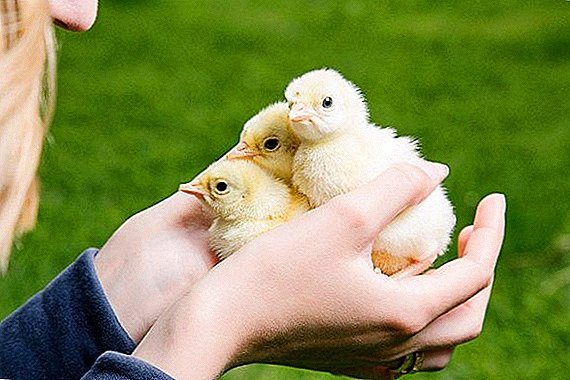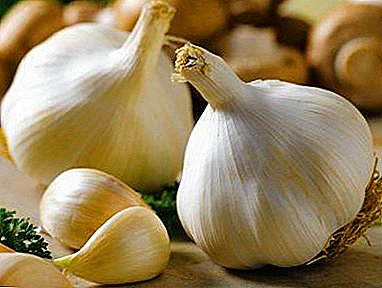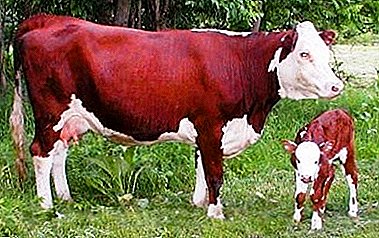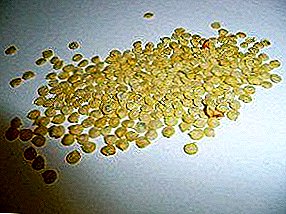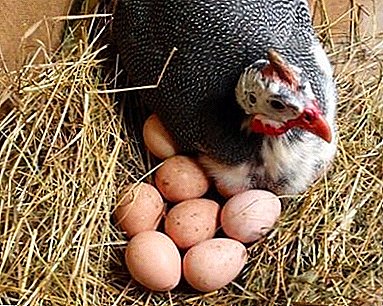
Guinea fowl - a bird that is a distant relative of the chicken. The appearance of guinea fowls resembles the exterior of turkeys. Individuals are unpretentious in the content, their meat has excellent taste characteristics.
Birds eggs contain a large percentage of useful elements. For breeding birds, it is important to know the basic rules of incubation. How to select guinea eggs and bookmark?
What it is?
 From the Latin term is translated as - "hatch", "withstand". This is a natural development process from the moment the egg is laid until the appearance of the individual. Incubation proceeds at a given environment: a certain temperature, humidity, lighting. An incubator is required for hatching guinea fowls at home or on an industrial scale. It must be a thermometer, heating system and lighting.
From the Latin term is translated as - "hatch", "withstand". This is a natural development process from the moment the egg is laid until the appearance of the individual. Incubation proceeds at a given environment: a certain temperature, humidity, lighting. An incubator is required for hatching guinea fowls at home or on an industrial scale. It must be a thermometer, heating system and lighting.
Features egg-laying properties of guinea fowls
When creating suitable housing conditions, an individual gives up to 120 eggs per year. Their size is less than chicken, the average weight is 45 grams. The shape of the egg resembles a pear. Feature - strong shell (2-3 times the density of the chicken). This provides protection against the penetration of microbes and the development of salmonellosis.
Guinea fowl eggs are easy to transport.. They are stored for a long time (up to 7 months). The shell is colored brown, rough to the touch.
Selection and storage of material
For incubation, it is recommended to take the eggs of the female, which is from 7 to 9 months. Allowable weight - 40-45 g, safe storage period - no more than 10 days. Keep the eggs in an upright position, the blunt end should be at the top. Before selection, the guinea fowl must be fed intensively (to give wet mash with fish and meat waste). Before laying each egg must see through and check.
IMPORTANT: It is recommended to take eggs of the same mass to create identical incubation conditions and the simultaneous appearance of chicks.
Signs of unsuitability
What eggs are not suitable for incubation? It is important to pay attention to the following indicators.:
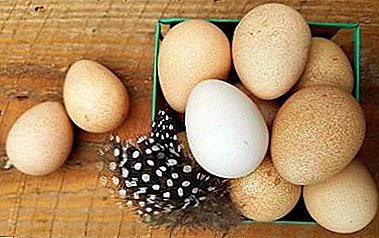 weight less than 35 g;
weight less than 35 g;- deformed shape;
- defects are visible on the shell (cracks or growths);
- inside viewed blood impurities;
- in egg 2 yolks;
- pollution (if the area of the dirty shell is more than 50%, the egg is usually not taken).
Store the selected eggs should be in compliance with the temperature, humidity and lighting. The room should not penetrate sunlight, the humidity level at the same time not less than 80%.
Preparing to bookmark
Before the procedure of laying eggs you need to keep 2-4 hours in a warm room. (this will allow them to heat up). Immediately put them in the trays can not, you need to wait until the device heats up to the desired mark (usually 38 degrees). When laying it is important to separate small from large eggs, put them in different containers. Contaminated specimens must be cleaned.
Disinfection
This is necessary to eliminate the dangerous microflora that develops on the shell (penetrating inside, it is harmful to the embryo). On farms, eggs are disinfected with formaldehyde fumes. Under private breeding conditions, a normal iodine solution or chloramine will do.
To wash or not to wash?
Not all farmers approve of washing, as wet shell - an ideal place for the development of fungus and various pathologies. If you decide to wash the eggs, use special antiseptics. These are Viroticide, Monklavit-1 and others.
The alternative is 1.5% hydrogen peroxide or potassium permanganate. The temperature of the products should be no higher than 30 degrees, the time for soaking - 3-5 minutes. After soaking the egg is taken out, then all impurities (dried feathers, droppings) are removed with a toothbrush. Next, lay the egg on a clean surface until completely dry.
Periods of development of the embryo
Embryo development occurs in 4 main stages. Throughout the time of growth of the embryo, it is important to regularly screening the contents (use the ovoscope).
 On 5 day in the center is a reddish spot with pronounced pink borders. A circulatory system is formed.
On 5 day in the center is a reddish spot with pronounced pink borders. A circulatory system is formed.- On 7 day the formation of a network of vessels.
- Through 2 weeks the embryo is visible as a saturated red spot.
- On 25-27 days nestling takes ¾ of the internal volume of the egg. Wings, nibbles and feet are finally formed.
All about incubators
In the device it is important to maintain the correct mode of moisture and temperature. To do this, use a thermostat. An incubator must necessarily have a battery for voltage control (will provide protection against power surges, overheating, or freezing of embryos). To maintain the desired humidity will help the evaporator.
Farmers distinguish between several types of hatchery cabinets:
- The first are household - These are small boxes that hold up to 110 eggs. Technical indicators are identical to the characteristics of other devices, hatchability of chicks 90%.
- The second type - farm. Allowed to breed individuals cyclically, accommodate up to 1000 eggs. Minus - the death of all embryos in case of failures and breakdowns.
- Last look - industrial. These are fully mechanized devices that are used in large chicken farms.
You can read about self-made incubator here.
Terms of ripening
For guinea fowl eggs, the incubation period is 26-28 days. This period is 7 days longer than that of chickens. During this time, the guinea fowl egg loses up to 15% of its initial weight. After the appearance of chicks, their strict selection is important: they should be preferred to sturdy individuals.
During the selection procedure, it is necessary to look at the umbilical ring, cloaca, paws - they should be of a bright orange color. Eyes in healthy tsarya bulge, fluff - brilliant.
Features of the regime in the incubator
 During the first 2 weeks, the temperature in the incubator should be 37.8 degrees, and the optimum humidity level for the period should be 60%. Later, the temperature should be gradually reduced by 1-2 tenths - to 37.6. Humidity level also needs to be reduced (50%).
During the first 2 weeks, the temperature in the incubator should be 37.8 degrees, and the optimum humidity level for the period should be 60%. Later, the temperature should be gradually reduced by 1-2 tenths - to 37.6. Humidity level also needs to be reduced (50%).
3 days before the end of incubation, the temperature returns to the original. If there are no automatic humidity settings in the room, a jar of water is placed in the equipment to further moisten the air. From the 6th day of hatching, the eggs should be cooled by lifting the incubator cover for 5-6 minutes, from the 14th day the duration increases (open for 10 minutes).
Table of regime and timing at home
Summary characteristics of the incubation mode in the private sector
| Day | Degrees (t) | Humidity level | Embryo monitoring |
| 1 - 12 | 37.8 ° C | 57-60% | On day 9 |
| 14 - 24 | 37.5 ° C | 48% | On day 14 |
| 25 - 27 | 37.8 ° C | When applied up to 95% | On day 26 |
Step-by-step detailed process instruction
Incubation is a painstaking process that requires adherence to a set of rules. Consider how many days the hen's eggs are laying in the incubator and what needs to be done.:
- Each egg needs to be heated evenly, but it is important to eliminate overheating - if the shell is hot, turn on the cooling system.
- Excretion in an incubator means airing. It should be carried out when the chicks begin to breathe (end of 3 weeks).
- On the 5-8th day, ovoscoping is done to eliminate unfertilized eggs.
- You need to turn the eggs 2-3 times a day. The first turning is done 12 hours after the bookmark. This is necessary for uniform heating and minimization of sticking of the embryos to the walls.
- Chicks will breed in 28 days.
- Individuals grow actively - in 3 months they are the size of an adult.
Watch the video about the features of the incubation of guinea fowl eggs:
- pheasant eggs;
- geese eggs;
- musk duck eggs;
- turkey eggs;
- Indoot eggs;
- quail eggs;
- duck eggs;
- eggs of peacocks;
- ostrich eggs.
Incubator Bookmark
 Warm up the incubator before placing the eggs. You can bookmark at any time, but farmers recommend doing it from 17 to 21 hours. It is important to sort the eggs by weight (small - 40 g, medium - 43 g, large - 45-47 g) and distribute them in different trays. You need to start the procedure with large eggs, to finish - with small ones. The total manual bookmark time is 4 hours with breaks.
Warm up the incubator before placing the eggs. You can bookmark at any time, but farmers recommend doing it from 17 to 21 hours. It is important to sort the eggs by weight (small - 40 g, medium - 43 g, large - 45-47 g) and distribute them in different trays. You need to start the procedure with large eggs, to finish - with small ones. The total manual bookmark time is 4 hours with breaks.
Translating: what time to do?
The action is called ovoskopirovaniya. The goal is to check the quality of eggs and the culling of damaged specimens. The biological control procedure is carried out on the 5th, 9th, 14th and 26th day. Eggs with a bloody and blurred ring are signs of death of the embryo..
The most common mistakes
Farmers, not knowing the characteristics of incubation of guinea fowls, often set the same regime for them as for chickens. This is a mistake, since removing guinea fowers requires more fine-tuning. The main differences from chicken eggs.
- Different weight. For guinea fowls - this is 40-45 g, for chickens - at least 50 g.
- Different period of incubation (it is shorter in chickens).
- Frequent mode of airing guinea fowl eggs due to the smaller size of the air chamber.
- Differences in shell density.
First steps after elimination
The first action after the removal of babies - careful selection. Healthy and strong chickens have a weight of 30-34 g. The young are friendly and active, for 2 days the individuals begin to hold on to their paws. In unhealthy chicks, the umbilical ring and cloaca are deformed, the eyes are dull, the beak is not formed.
Watch a video about selecting healthy guinea fowl chicks after hatching:
Conclusion
Breeding guinea fowls is an interesting but difficult task. Meat and eggs of these birds are of great value in the market, so breeding individuals is also a profitable business. During incubation, it is important to observe the regime and conduct regular x-raying of eggs.


 weight less than 35 g;
weight less than 35 g; On 5 day in the center is a reddish spot with pronounced pink borders. A circulatory system is formed.
On 5 day in the center is a reddish spot with pronounced pink borders. A circulatory system is formed.